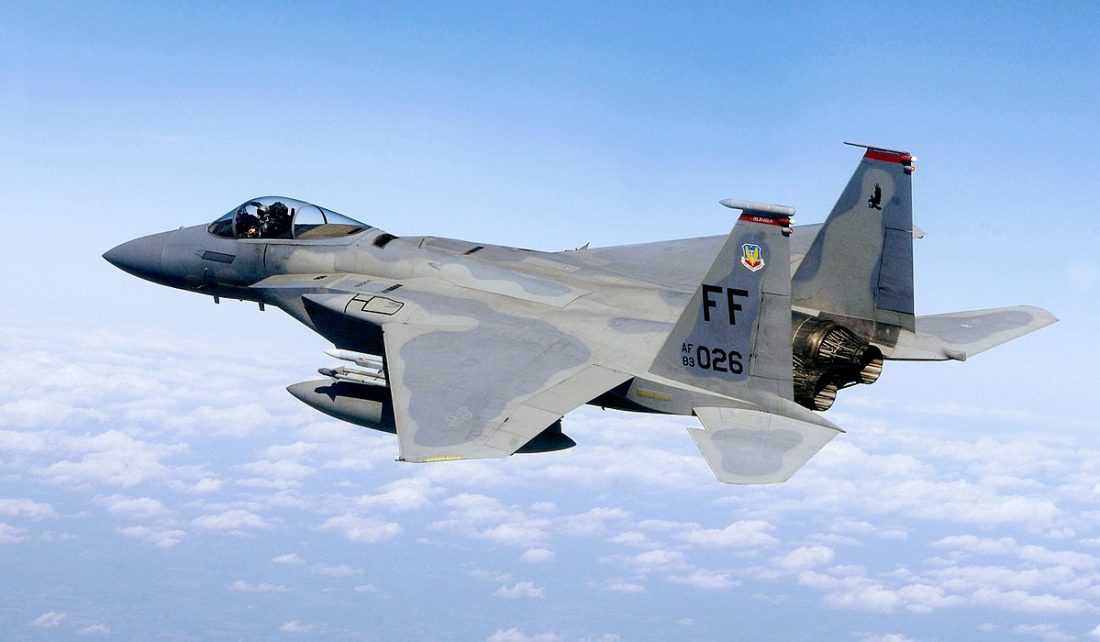Fighter jet’s sonic boom resounds far and wide

An F-15C Eagle from the U.S. Air Force’s 71st Fighter Squadron, 1st Fighter Wing, at Langley Air Force Base, Virginia, flies a combat air patrol mission in October 2007 over Washington, D.C. (Provided photo — Staff Sgt. Samuel Rogers, USAF)
An F-15C Eagle fighter jet from Barnes Air National Guard Base in Westfield, western Massachusetts, was flying more than 30,000 feet over northern New York Thursday morning when it performed a tactical maneuver, breaking the sound barrier at around 10:30 a.m., according to base officials. As a result, a loud “boom” shook buildings and people throughout the region.
Dozens of people said on the Enterprise Facebook page that they heard the boom, all the way from towns along the Canadian border — such as Mooers, Churubusco and Burke — to Crown Point, Schroon Lake and Newcomb roughly 100 miles away.
“It was so big that it shook my house like an earthquake,” Kasie Amo posted. “Sounded like a massive bomb went off right over my house in Ray Brook.”
Master Sgt. Lindsey Watson of Barnes Air National Guard Base — home of the 104th Fighter Wing — said the fighter squadron commander confirmed that the base’s jet caused the boom. Watson said the jet was flying above 30,000 feet, the minimum height at which the Federal Aviation Administration allows supersonic travel.
There have been jets overhead in the region all summer and multiple sonic booms, from multiple military agencies, but in Saranac Lake, at least, this was the loudest and drew a big public response.
While some viewed it as an unwelcome disturbance, others wrote that it was a comforting reminder that the military is defending the nation.
Military fly-bys were much more common in the North Country before the U.S. Air Force closed its Plattsburgh base in the 1990s.
–
How sonic booms work
–
A jet produces a sonic boom when it is traveling faster than the speed of sound, a speed which varies depending on a number of factors, including altitude and temperature. At 30,000 feet, the speed of sound is about 670 miles per hour. But at that height a jet must travel 750 mph for the boom to be heard on the ground.
Vermont Air National Guard public affairs spokesperson Maj. Scott Detweiler said a sonic boom projects in a cone outward from the front of a plane as it goes supersonic. If the nose of the plane is facing downward, he said, that boom can be heard and felt on the ground; if the nose is upward, the boom goes into the atmosphere and isn’t heard on the ground.
Detweiler is not a pilot, but as one who fields questions and complaints from the public, he said he asks pilots to generally try to avoid sonic booms that can be heard at ground level, although sometimes these happen unintentionally.
“Our pilots keep a log of any sonic boom that they create, intentional or unintentional” he said.
The Vermont Air National Guard has been flying its new F-35A Lightning II jets over the Adirondacks this summer, and last week it announced night flights between 5 and 10 p.m. this week. These started Tuesday and end Friday.
As for Thursday morning’s sonic boom, “Our planes are not in the air right now,” Detweiler said. “I can say with 100% certainty it was not us.”
–
Boom summer
–
Nathan Miller of Saranac Inn called the Enterprise to say Thursday’s sonic boom may have been the biggest one yet. He said he has been seeing and hearing military jets all summer and that the booms have cracked two older windowpanes in his house.
“It’s getting ridiculous,” he said.
Diana Webster lives on Indian Carry Road near Upper Saranac Lake. Her house was built in 1880, and she’s been there since 2011. She also called the Enterprise to say this was a particularly loud sonic boom.
“I’ve felt the impact on my house before, but this was above and beyond,” she said. “Literally I thought a tree fell on the house.”
She planned to check her attic for damage.
“They need to know that they’re not flying over nothing,” she said.
Detweiler said people who claim property damage or injury due to military jet sonic booms may fill out a Standard Form 95 and submit it to Hanscom Air Force Base in Massachusetts, which handles such claims for the northeratern U.S.





